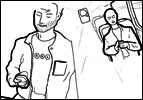 |
 |
THE CONCEPT
A system for managing a user's phone in a way that makes sense to THAT USER

SCENARIOS

ABOUT THE WORKSHOP
Applied dreams are short innovation workshops developed jointly by IDII faculty and industrial partners, In this case it was Nokia's Insight and Foresight Group and Nokia Research.
The workshop's topic was "Blue collar Mobility ".
Mobile phones have the potential to augment personal and professional life, especially its collaborative and social components.
Attention has so far focused on domestic and 'white-collar' services and applications.
But which mobile-related design service, application or device would improve the efficiency and working experience of 'blue-collar' professionals? FACULTY:
Neil Churcher, Jan-Christoph zoels
Team:
Ruth kikin-Gil, Erez kikin-Gil, Nathan Waterhouse, Oznur Ozkurt
|
 |
|
 |
UNDERSTANDING OUR USERS
|
 |
 |

The Method
In our design process we have used methods which allowed us to better understand our users. We conducted interviews; we explored our users' environment and the tools they work with.
Based on that, we mapped their behaviors and activities. Our belief is that the best designed tools and services are the result of deeper understanding of the user's needs and desires.
Secondary research
In order to understand what defines blue collar workers we looked at various information sources, such as industry news, relevant research, and market reports. Specifically we looked at how mobile technology has been useful to the blue collar sector. This research gave us a fundamental understanding of the area we are designing for and of pre-existing solutions.
Job task analysis
In this stage, we mapped the cognitive processes and actions our users required when performing their daily tasks. We have assembled a detailed task flow, which we then used as a guide for our design. The information gathered allowed us to understand the general workflow and focus on detailed tasks and activities
.User Interviews
We conducted interviews across a range of blue-collar industries. From a captain lieutenant of the Carabinieri (Italian armed police) to painters and exhibition organizers, to name a few. In total there were eight businesses interviewed. With respect to the time-frame, we spent a great deal of time asking people about their needs and learning what their pain points were. |
|
 |
Pain Point 1: Hard to access the data when mobile
|
|
 |

|
|
 |
"I wish I would press the magic button and the phone will transform into a laptop and back again"
Rory, Event Organizer, UK
insights:
Mobility is one of the core aspects to our user group, and the methods they
currently use to reach their data are not the most efficient.
When we asked Rory how he manages all the information related to a job, he
said "I use files, you know, files."
What he actually meant was Excel files that
keep the contact information and related material to the job.
Rory and his partner prepare these files and print them to use while working on- site.
Many of our users don't use their computers in a way that suits their mobile
work style.
Computers usually stay in the office and are not taken to the work
site, because they can get dirty, broken. This doesn't apply to cell
phones, since they can keep the phone in their pockets or cover it to protect.
|
|
 |
Pain Point 2: Too many contacts
|
|
 |

|
|
 |
"My phone is full of contacts, I worry about deleting them because I don't know who they are;
I need another list to remind me who they are"
Piers, Event Organizer, UK
insights:
One characteristic of the self-employed blue collar worker group is that they depend on their contact lists very much.
Piers from Designers
Block said that what makes them Designers Block, is the people they know. Others can't copy their work because they won't have the
same contacts. When the contact lists grow bigger and bigger, it becomes harder to remember who all the names in the list are.
One of our interviewees, Tino, solves this problem by adding abbreviations to contacts name to remind him who that person is. For example, paulo.vw.it in Tino's contact list is a Paulo that works for Volkswagen in Italy.
|
|
 |
Pain Point 3: INFORMATION IS SCATTERED
|
|
 |

|
|
 |
"I keep an agenda for work."
"My wife takes care of my accounts, she uses word pad."
"I take photos of my work and print them, they are somewhere at home."
Constantin, Painter, Romania/Italy
insights:
Usually the data our users need are scattered, some information is kept in their computers, some is written down in their personal agendas.
Tino keeps the information related to his work in many different places; an agenda, his computer, and he doesn't remember where he puts the photos he takes for reference. So when he needs a document related to his job, he has to go through many different places to find what he is looking for. This leads to inconvenience especially when the user is
looking for a specific data related to a job in a remote location far from his office.
One of our interviewees, George, actually said if the files are not kept properly, they come back and haunt you.
|
|
 |
Pain Point 4: BACK-UP IS A BURDEN
|
|
 |

|
|
 |
"First time I lost my cell phone, all my contact list was gone,
and I lose a cell phone every month.
Now I write my contact list in a notebook, because phones get lost."
Luciano, Painter, Italy
insights:
Backing up data is obviously important for our users. Luciano, a painter from Italy told us that after he lost his phone for the first time, he started
writing his contacts down in a notebook, and every time he loses his phone, he buys a new phone and a sim card and enters his whole contact list manually. Although he is a skilled computer user, he doesn't use the backup functionality of his phone.
|
|
| |
To learn more about the solution read about The FLOW concept
To understand how it might actually work look at the Scenario
|
|
